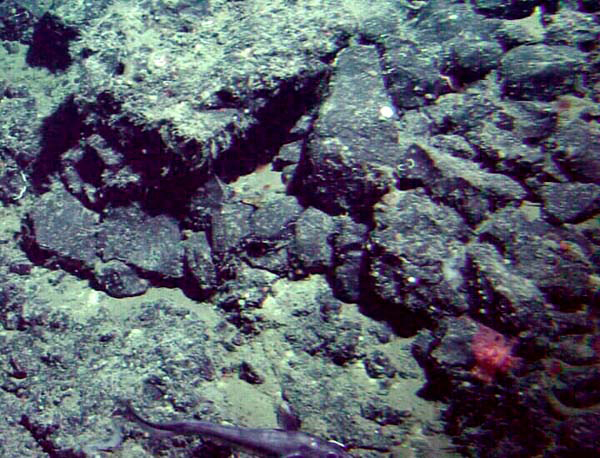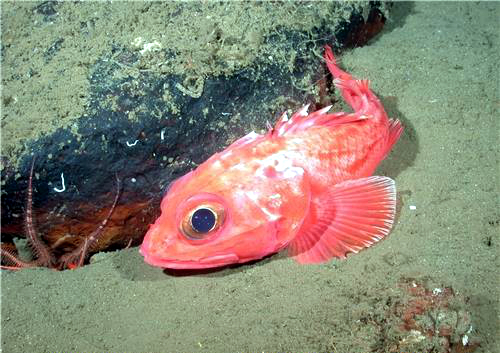|
Patton Seamount
Patton Seamount is a prominent seamount (Submarine volcano, underwater volcano) in the Cobb–Eickelberg Seamount chain in the Gulf of Alaska. Located east of Kodiak Island and reaching to within of the ocean surface, Patton is one of the largest seamounts in the Cobb–Eickelberg Seamount chain. It was originally created near the coast of Oregon by the Cobb hotspot 33 million years ago, and was moved to its present location by tectonic plate movement. Patton is one of the most well-understood seamounts, as a major expedition using ''DSV Alvin'' in 1999 and another in 2002 helped define the scope of the seamount's biological community. Like other large seamounts, Patton acts as an ecological hub for sea life. Dives have revealed that the volcano is heavily encrusted in sea life of various forms, including sea stars, corals, king crabs, demersal Shortraker rockfish, rockfish, and other species. Geology Patton Seamount was created by the Cobb hotspot, and it lies in the Cobb– ... [...More Info...] [...Related Items...] OR: [Wikipedia] [Google] [Baidu] |
Seamount
A seamount is a large geologic landform that rises from the ocean floor that does not reach to the water's surface (sea level), and thus is not an island, islet or cliff-rock. Seamounts are typically formed from extinct volcanoes that rise abruptly and are usually found rising from the seafloor to in height. They are defined by oceanographers as independent features that rise to at least above the seafloor, characteristically of conical form.IHO, 2008. Standardization of Undersea Feature Names: Guidelines Proposal form Terminology, 4th ed. International Hydrographic Organization and Intergovernmental Oceanographic Commission, Monaco. The peaks are often found hundreds to thousands of meters below the surface, and are therefore considered to be within the deep sea. During their evolution over geologic time, the largest seamounts may reach the sea surface where wave action erodes the summit to form a flat surface. After they have subsided and sunk below the sea surface such flat ... [...More Info...] [...Related Items...] OR: [Wikipedia] [Google] [Baidu] |
Pacific Plate
The Pacific Plate is an oceanic tectonic plate that lies beneath the Pacific Ocean. At , it is the largest tectonic plate. The plate first came into existence 190 million years ago, at the triple junction between the Farallon, Phoenix, and Izanagi Plates. The Pacific Plate subsequently grew to where it underlies most of the Pacific Ocean basin. This reduced the Farallon Plate to a few remnants along the west coast of North America and the Phoenix Plate to a small remnant near the Drake Passage, and destroyed the Izanagi Plate by subduction under Asia. The Pacific Plate contains an interior hot spot forming the Hawaiian Islands. Boundaries The north-eastern side is a divergent boundary with the Explorer Plate, the Juan de Fuca Plate and the Gorda Plate forming respectively the Explorer Ridge, the Juan de Fuca Ridge and the Gorda Ridge. In the middle of the eastern side is a transform boundary with the North American Plate along the San Andreas Fault, and a boundary with the ... [...More Info...] [...Related Items...] OR: [Wikipedia] [Google] [Baidu] |
Suspension Feeder
Filter feeders are a sub-group of suspension feeding animals that feed by straining suspended matter and food particles from water, typically by passing the water over a specialized filtering structure. Some animals that use this method of feeding are clams, krill, sponges, baleen whales, and many fish (including some sharks). Some birds, such as flamingos and certain species of duck, are also filter feeders. Filter feeders can play an important role in clarifying water, and are therefore considered ecosystem engineers. They are also important in bioaccumulation and, as a result, as indicator organisms. Fish Most forage fish are filter feeders. For example, the Atlantic menhaden, a type of herring, lives on plankton caught in midwater. Adult menhaden can filter up to four gallons of water a minute and play an important role in clarifying ocean water. They are also a natural check to the deadly red tide. Extensive article on the role of menhaden in the ecosystem and possible r ... [...More Info...] [...Related Items...] OR: [Wikipedia] [Google] [Baidu] |
Sea Anemone
Sea anemones are a group of predation, predatory marine invertebrates of the order (biology), order Actiniaria. Because of their colourful appearance, they are named after the ''Anemone'', a terrestrial flowering plant. Sea anemones are classified in the phylum Cnidaria, class Anthozoa, subclass Hexacorallia. As cnidarians, sea anemones are related to corals, jellyfish, tube-dwelling anemones, and ''hydra (genus), Hydra''. Unlike jellyfish, sea anemones do not have a Jellyfish#Life history and behavior, medusa stage in their life cycle. A typical sea anemone is a single polyp (zoology), polyp attached to a hard surface by its base, but some species live in soft sediment, and a few float near the surface of the water. The polyp has a columnar trunk topped by an oral disc with a ring of tentacles and a central mouth. The tentacles can be retracted inside the body cavity or expanded to catch passing prey. They are armed with cnidocytes (stinging cells). In many species, additional n ... [...More Info...] [...Related Items...] OR: [Wikipedia] [Google] [Baidu] |
Brittle Star
Brittle stars, serpent stars, or ophiuroids (; ; referring to the serpent-like arms of the brittle star) are echinoderms in the class Ophiuroidea, closely related to starfish. They crawl across the sea floor using their flexible arms for locomotion. The ophiuroids generally have five long, slender, whip-like arms which may reach up to in length on the largest specimens. The Ophiuroidea contain two large clades, Ophiurida (brittle stars) and Euryalida (basket stars). Over 2,000 species of brittle stars live today. More than 1,200 of these species are found in deep waters, greater than 200 m deep. Range The ophiuroids diverged in the Early Ordovician, about 500 million years ago. Ophiuroids can be found today in all of the major marine provinces, from the poles to the tropics. Basket stars are usually confined to the deeper parts of this range; Ophiuroids are known even from abyssal (>6,000 m) depths. However, brittle stars are also common members of reef communities, where t ... [...More Info...] [...Related Items...] OR: [Wikipedia] [Google] [Baidu] |
Lithodes
''Lithodes'' is a genus of king crabs. Today there are about 30 recognized species, but others formerly included in this genus have been moved to ''Neolithodes'' and ''Paralomis''. They are found in oceans around the world, ranging from shallow to deep waters, but mostly at depths of . They are restricted to relatively cold waters, meaning that they only occur at large depths at low latitudes, but some species also shallower at high latitudes. They are medium to large crabs and some species are or were targeted by fisheries.Emmerson, W.D. (2016). A Guide to, and Checklist for, the Decapoda of Namibia, South Africa, vol. 2. Cambridge Scholar Publishing. Species ''Lithodes'' contains the following species: *''Lithodes aequispinus'' Benedict, 1895 – golden king crab *''Lithodes aotearoa'' Ahyong, 2010 *''Lithodes australiensis'' Ahyong, 2010 *''Lithodes ceramensis'' Takeda & Nagai, 2004 *'' Lithodes chaddertoni'' Ahyong, 2010 *''Lithodes confundens'' Macpherson, 1988 *'' Litho ... [...More Info...] [...Related Items...] OR: [Wikipedia] [Google] [Baidu] |
Embassichthys Bathybius
The deepsea sole (''Embassichthys bathybius'') is a flatfish of the family Pleuronectidae. It is a bathydemersal fish that lives on muddy bottoms at depths of between , though it is most often found at depths of . Its native habitat is the northern Pacific, from Japan Japan ( ja, 日本, or , and formally , ''Nihonkoku'') is an island country in East Asia. It is situated in the northwest Pacific Ocean, and is bordered on the west by the Sea of Japan, while extending from the Sea of Okhotsk in the north ... to the Gulf of Alaska and down the Pacific coasts of Canada and the USA as far south as Mexico. It grows up to in length. References deepsea sole Fish of the North Pacific deepsea sole {{Pleuronectiformes-stub ... [...More Info...] [...Related Items...] OR: [Wikipedia] [Google] [Baidu] |
Sebastolobus
''Sebastolobus'', the thornyheads, is a genus of marine ray-finned fish belonging to the subfamily Sebastinae, the rockfishes, part of the family Scorpaenidae. These fishes are native to the northern and eastern Pacific Ocean. They are generally found in deep waters. Taxonomy ''Sebastolobus'' was first described as a genus by the American ichthyologist Theodore Gill in 1881 with ''Sebastes macrochir'', a species described, with its type locality given as Japan, by the German-born British ichthyologist and herpetologist Albert Gunther in 1877. It is the type genus of the tribe Sebastolobini, on of two in the Sebastinae, a subfamily of the family Scorpaenidae. The generic name is a compound of ''Sebastes'', the original genus of the type species, and ''lobus'', “lobed”, a reference to the lower rays of the pectoral fins being widened into tongue-shaped lobes. Species There are currently three recognized species in this genus: Characteristics ''Sebastolobus'' thornyheads ha ... [...More Info...] [...Related Items...] OR: [Wikipedia] [Google] [Baidu] |
Sebastes
''Sebastes'' is a genus of marine ray-finned fish belonging to the subfamily Sebastinae part of the family Scorpaenidae, most of which have the common name of rockfish. A few are called ocean perch, sea perch or redfish instead. They are found in the Atlantic and Pacific Oceans. Taxonomy ''Sebastes'' was first described as a genus in 1829 by the French zoologist Georges Cuvier, the Dutch ichthyologist Pieter Bleeker designated ''Perca norvegica'', which may have been originally described by the Norwegian zoologist Peter Ascanius in 1772, as the type species in 1876. The genus is the type genus of both the tribe Sebastini and the subfamily Sebastinae, although some authorities treat these as the subfamily Sebastinae and the family Sebastidae, separating the Sebastidae as a distinct family from the Scorpaenidae. but other authorities place it in the Perciformes in the suborder Scorpaenoidei. Some authorities subdivide this large genus into subgenera as follows: * ''Sebastes'' ... [...More Info...] [...Related Items...] OR: [Wikipedia] [Google] [Baidu] |
Endemism
Endemism is the state of a species being found in a single defined geographic location, such as an island, state, nation, country or other defined zone; organisms that are indigenous to a place are not endemic to it if they are also found elsewhere. For example, the Cape sugarbird is found exclusively in southwestern South Africa and is therefore said to be ''endemic'' to that particular part of the world. An endemic species can be also be referred to as an ''endemism'' or in scientific literature as an ''endemite''. For example '' Cytisus aeolicus'' is an endemite of the Italian flora. '' Adzharia renschi'' was once believed to be an endemite of the Caucasus, but it was later discovered to be a non-indigenous species from South America belonging to a different genus. The extreme opposite of an endemic species is one with a cosmopolitan distribution, having a global or widespread range. A rare alternative term for a species that is endemic is "precinctive", which applies to ... [...More Info...] [...Related Items...] OR: [Wikipedia] [Google] [Baidu] |
NOAA
The National Oceanic and Atmospheric Administration (abbreviated as NOAA ) is an United States scientific and regulatory agency within the United States Department of Commerce that forecasts weather, monitors oceanic and atmospheric conditions, charts the seas, conducts deep sea exploration, and manages fishing and protection of marine mammals and endangered species in the U.S. exclusive economic zone. Purpose and function NOAA's specific roles include: * ''Supplying Environmental Information Products''. NOAA supplies to its customers and partners information pertaining to the state of the oceans and the atmosphere, such as weather warnings and forecasts via the National Weather Service. NOAA's information services extend as well to climate, ecosystems, and commerce. * ''Providing Environmental Stewardship Services''. NOAA is a steward of U.S. coastal and marine environments. In coordination with federal, state, local, tribal and international authorities, NOAA manages the ... [...More Info...] [...Related Items...] OR: [Wikipedia] [Google] [Baidu] |








.jpg)
